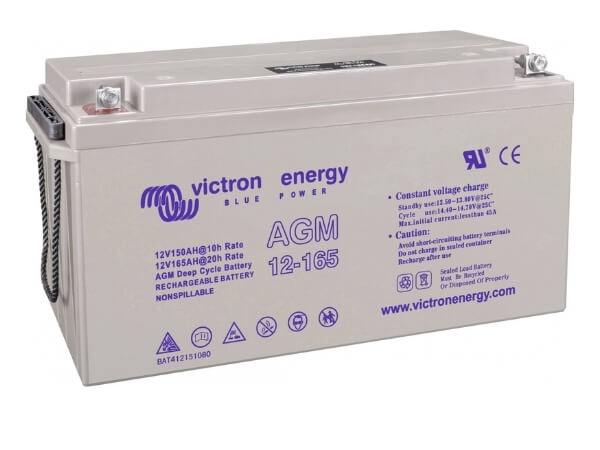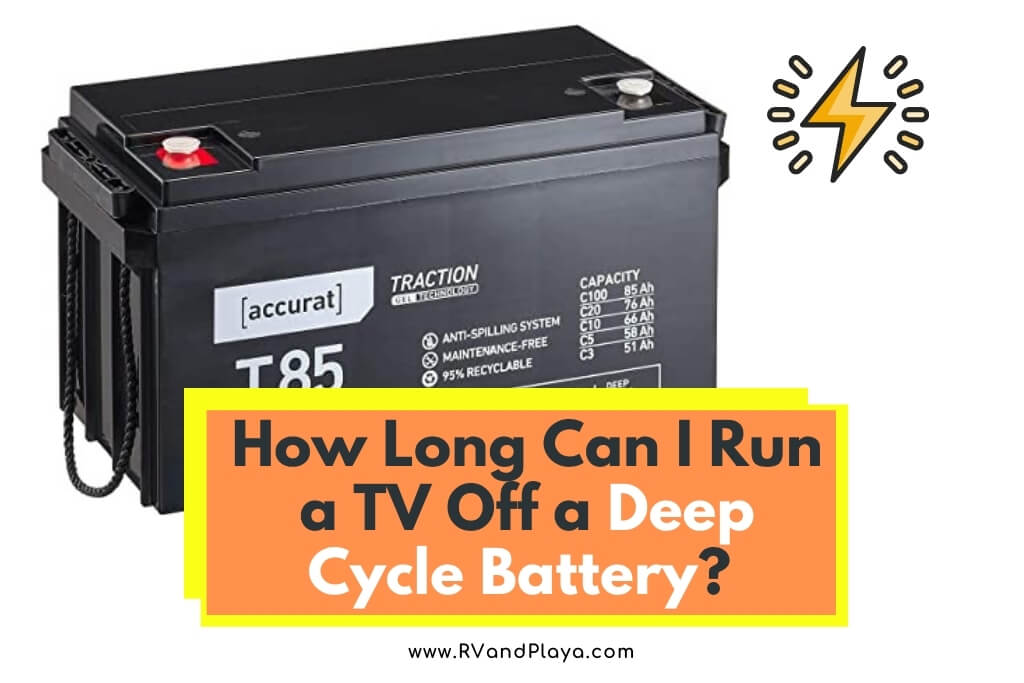How long can I run a TV off a deep cycle battery? This is one of the questions our readers ask a lot.
When you are camping or RVing you will very likely occasionally get bored, which is the reason why it is a rare sight of an RV or a camper trailer without a TV set.
You might be wondering for how long can a TV be powered by a deep cycle battery? On average you can run a TV off a deep cycle battery for around 8 to 20 hours depending on the size and the power consumption of your TV. While modern TV sets are very power efficient, the actual running time on a deep cycle battery depends on its power draw and the capacity of the battery.
Table of Contents
How Long Can A TV Run On A Deep Cycle Battery?
Deep cycle battery has a decreasing capacity with increasing current drawn from them, a TV that draws twice the current of some other TV will not run half the time, but less.
For example, a 60 watts 45-inch LED TV would need the inverter to draw 5 amps of current, and you would be able to use it on a typical 105 Ah lead-acid deep cycle battery for around 23 hours.
But a 120 watts jumbotron you will not be able to use around 11.5 hours, instead, it will be just a little over 8 hours.
The table below shows how many hours you need to power a TV on a deep cycle battery:
| Screen Size (Inches) | Power LED – TV (Hours) | Power Plasma TV (Hours) |
|---|---|---|
| 30 | 20 | 5 |
| 32 | 18 | 4,5 |
| 37 | 16 | 4 |
| 40 | 14 | 3,6 |
| 42 | 12 | 3,3 |
| 50 | 10 | 2,4 |
| 55 | 9 | 1,9 |
| 60 | 8 | 1,4 |
How Much Power Does A TV Use?
The electrical power consumption of a TV depends mostly on the size and technology its screen is made of.
While TV sets also have speakers, and many modern ones come with various connectivity features that also use electricity, the screen is still the largest consumer.
WiFi antennas, Bluetooth, and many other things; have a very small impact on consumption.
When it comes to technology the screen is made of, most modern TVs use some form of LED, OLED, or similar technology.

Between them, there are significant differences in maximum power consumption. For example, OLED TVs usually have a 25% higher maximum power than equivalent LED backlight TVs.
“When it comes to the size of a screen, power consumption is somewhat proportional to the surface area, and the bigger the screen, the more power it will draw.”
Some average maximum power consumption for TVs, which can be used for calculating ballpark figures, for a 32-inch LED TV is around 41 watts, for OLED TV of the same size around 57 watts.
A 40-inch TV will draw around 50 and 72 watts respectively, while for a 50-inch TV it is 72 and 89 watts.
The exact maximum power consumption depends on many more factors, such as the maximum brightness, resolution, the exact chemistry of the screen, and so on; and it varies not just between manufacturers, even when they use the same type of technology, but also between their individual models.
That’s why most manufacturers have it printed on the energy label on the back of the TV.
Read also: Can a TV Run on a 12V Battery? [This Is How]
Knowing the maximum power consumption of a TV will allow you to calculate what is the minimum running time you can have on a deep cycle battery.
The reality is that TVs very rarely work at the maximum load, and consumption depends quite a lot on the nature of the image that is displayed.
Dark colors and scenes request much less energy than bright ones and also decreasing the overall brightness to 50% can lower consumption by nearly 45%.
Because of this, TVs on average consume between 20% and 30% of their maximum wattage during some average use.
The exact draw you can’t calculate, but you can measure with measuring devices such as Kill A Watt.
Read also: How Many Amps Does A 32 Inch LED TV Use? (Explained)
Once you know the draw of your TV, you can easily calculate the expected running time. But first the number you know, you need to divide it by 12V to get how many amps is converter drawing to power the TV and it is a number more convenient for calculation.
Next, you need to divide the battery’s Ah capacity by the calculated amperage of your TV.
This will give you a ballpark figure, your actual experience depends on several other things related to the battery capacity.
Another thing you should have in mind is the efficiency of the power inverter, which is usually between 85% and 95%.
What Is The Capacity Of A Deep Cycle Battery?
In the simplest terms, deep cycle battery capacity is the number of hours it can supply a certain continuous current before its voltage drops to a shutoff value.
Most commonly, the nominal capacity is determined by the manufacturer by drawing a constant current over the period of 20 hours.
By multiplying this amperage with 20 they get the nominal capacity of the battery.
For example, a typical 105Ah capacity rating means that such a battery can provide 5.25 amps continuously over 20 hours.
When a deep cycle battery is being discharged, how long it will be able to supply electricity depends on the current that is drawn from it.
A higher amperage draw will mean a shorter usage time, lower amperage will yield a longer usage time. And this ratio is not proportional.
For example, a typical 105Ah rated lead-acid deep cycle battery will last for just one hour if the current drawn from it is 37.8 amps.
Though the common sense calculation by dividing the higher amperage with the lower one, and then dividing known running time with a calculated number suggests that the running time at 37.8 amps should be closer to 2.7 hours.
Deep Cycle Battery Limitations >> Check out the video below:
Conversely, when calculating with the common-sense method from the one-hour running time at 37.8 amps, you would erroneously conclude that at 1.4 amps draw the battery would supply power for 27 hours, but in reality, said the battery would have lasted whole 100 hours.
This is the reason why some of the top deep cycle battery manufacturers will, besides the nominal 20 hours capacity, also provide 5, 10, and 100 hours capacities and current they can provide over these periods of time. Sometimes also the 1, 8, and 15 hours.
Read also: How Many Watt Solar Panel To Charge Deep Cycle Battery? (Explained)
How long you can run a TV on a deep cycle battery depends primarily on the power draw of said TV and the capacity of the battery you are using.
The power draw of a TV depends on its size and technology used for making the screen.
While the maximum power consumption you can find printed on its back, typical consumption is usually 3 to 5 times slower, so the only certain thing is to actually measure it during the use.
When it comes to battery, the nominal capacity is the measure of current it can supply over a period of 20 hours.
For the best estimate of running time, the safest is to compare the power draw needed for running your TV with the spec sheet of battery.
How To Tell If a Deep Cycle Battery Is Bad
To tell if a deep cycle battery is bad or good, you need to make a simple battery inspection which includes:
- Check if there is a broken terminal,
- Check if there is a bulge or bump in the case
- Check if there is a crack or rupture of the case,
- Check for excessive leaking and discoloration
- Broken or loose terminals are dangerous, and can cause a short circuit.5
Deep Cycle Battery Maintenance – Testing Batteries Before You Leave >> Check out the video below:
How to Test a Motorcycle Battery Without Multimeter
To test a motorcycle battery without a multimeter, you need to check if there are broken or loose terminals which could be dangerous and can cause a short circuit. Also inspect bulges, cracks and look for excessive leaking.
Use a Multimeter to Test Motorcycle Battery >> Check out the video below:
AGM Battery Voltage Chart
The table below shows the agm battery voltage chart
| Level | Voltage |
|---|---|
| 100% | 13,00V |
| 90% | 12,75V |
| 80% | 12,50V |
| 70% | 12,30V |
| 60% | 12,15V |
| 50% | 12,05V |
| 40% | 11,95V |
| 30% | 11,81V |
| 20% | 11,66V |
| 10% | 11,51V |
| 0% | 10,50V |
The Different Types of Deep Cycle Batteries
To know the different types of deep cycle batteries >> Check out the video below:
Deep Cycle Battery Buyer´s Guide
All deep-cycle batteries aren’t created equal! In fact, there’s a whole lot more than the specs you read on paper, and in reality, there’s often huge differences under a battery’s casing that can make a massive difference in your camping experience, and how much you can power off your battery.
Below you can find the best deep cycle batteries which include:
- Ampere Time LiFePO4 Deep Cycle Battery
- Lossigy LiFePO4 Deep Cycle Battery
- Miady LiFePO4 Deep Cycle Battery
- Weize LFP1200 Deep Cycle Battery
- Optima OPT8016-103 Marine Deep Cycle Battery
- VMaxTanks V35-857 Marine Deep Cycle Battery
- XS Power D3400 Deep Cycle Battery
References
https://www.deepcyclemarinebattery.com
Recent Posts
How Many Watt Solar Panel To Charge Deep Cycle Battery? (Explained)
If you have an RV then, chances are, that it will be loaded with deep cycle batteries. It is these batteries that will store any excess power produced by your generators or solar panels. This...
This Is Why Your RV Battery Is Overheating? (Read This First)
Recreational vehicles, or RVs, come in all shapes and sizes. Whether you buy yours from an RV manufacturer or convert one from a used bus or van, it is a must to have a battery charging system....

